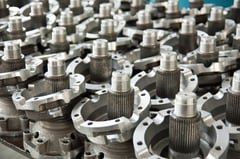
AMRs in the spotlight: B2C Ecommerce
If you think of “New technologies” and “Intralogistics” the letters “AMR” often naturally follow. Autonomous Mobile Robots are the kind of technology that’s often assumed to be the future of so many forms of warehousing, distributing, and other kinds of logistical operations.
But are they always well suited to every sector?
Over the next few weeks, the Invar Group will be trying our best to answer that question. Sector by sector, we’re going to look at where and how AMRs fit into the broader situational ecosystem. We’ll be discovering where they work well, where they don’t, and most importantly – why?
B2C Ecommerce – S-Tier
Of all the sectors and marketplaces with a noteworthy presence in the minds of intralogicians everywhere, business-to-consumer ecommerce is perhaps the most natural and logical adopter of AMRs that you could find anywhere. The following are some of the reasons for this, and while a selection of these do apply in other sectors, others come together in B2C ecommerce to create a perfect storm of AMR applicability.
Digital natives – B2C Ecommerce combines naturally with AMRs because of the digital nature of the order receipt process. The chain process from customer placing an order to AMR receiving it’s directions need have no single stage at all where manual error can muddy the waters. While other sectors could well make use of such situations, they do not come together with many other reasons here mentioned.
Range of scale – B2C Ecommerce operations arguably come in a far wider range of shapes and sizes than many other sectors. There is only so “small” your business can be when you are supplying aircraft parts or industrial lifting equipment. However, from microbrewing all the way to international beverage consortiums, B2C ecommerce can radically range in size and scale. And AMR operations fit them all. Due to the scalability in numbers of robots, and the low profile installation component of the solutions, AMRs work very well at every scale ecommerce operates on.
High expectations – Many different sectors expect great things from their suppliers. This is why phrases like “just-in-time” supply chains, and “last mile problem” have become ubiquitous among almost every sector when discussing intralogistics and the challenges of getting your goods where they are most needed/wanted at exactly the right time.
However, very few sectors see higher and higher percentages of their customer-client base refusing to trade because orders cannot be processed, packed, and fulfilled within less than 12 hours. Because of this, the speed this kind of robotics offers more advantage than any other sector. When considering this issue in the light of the final biggest reason behind B2C ecommerce needing AMRs, it’s hard to see it as anything less than an S-tier case of AMR applicability.
Ultra-complex product ordering - The B2C ecommerce sector has perhaps the single most demanding and complicated array of possible product situations of any sector of the economy. A single company could hold any number of wildly different or highly varied yet closely related products at any one time. A company could hold everything from bookends to basket-weaving kits in the same warehouse, or they might have thirteen different varieties of the same cable knit jumper, all in seven different sizes at least.
Not only is the level of product range complexity at issue, it is combined with the relatively low number of items per order. An ecommerce order can have as few as one to four or as many as fourteen to forty five or many more in a single order. However in most B2C ecommerce situations the former end of that spectrum is the norm. This creates many different journeys around the warehouse, all complicated and interlinking into each other in intricate and difficult ways. Something far better suited to the high speed, low profile, zero error set up of AMRs.
The perfect storm for autonomous robotics – When it comes to AMRs in the future, not every sector or industry will need AMRs in the same way as every other. There may be load considerations, mobility factors, or collaborative technology requirements that make other technologies better suited to automating those sectors. But it’s hard to argue that when it comes to B2C ecommerce, AMR applicability reaches an S-tier status.
If your business wants to be moving smarter, faster, and more efficiently, Invar can find a way to make that happen. Maybe it will be AMRs, maybe it’ll be something else entirely. We don’t care what the solution is. We only care that it works. If you’re interested in AMRs, conveyors, carousels, or any other intralogistics solutions to your business situation, take time to talk to the Invar Group today.
Written by

Michael Trimmer

Contact Us
Contact us for further independent advice on transforming operational performance in the warehouse.
Contact usRelated Articles

AMRs in the spotlight: Manufacturers (B-Tier)
Is the robotic revolution really right round the corner? Is automation the automatic assumption of...
Read More
AMRs in the spotlight: Pharmaceuticals
What do Issac Azimov, Hollywood blockbusters, and the wider intralogistics community have in...
Read More
AMRs in the spotlight: Industrial parts
Autonomous Mobile Robots (AMRs) stand as a beacon of innovation, captivating various sectors with...
Read More